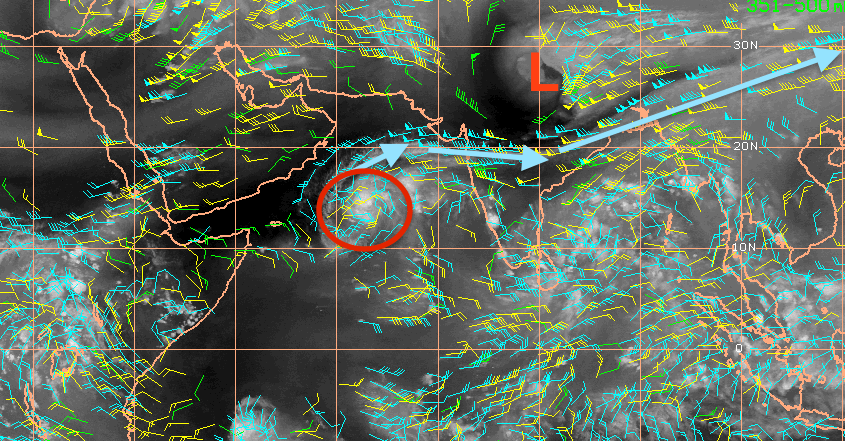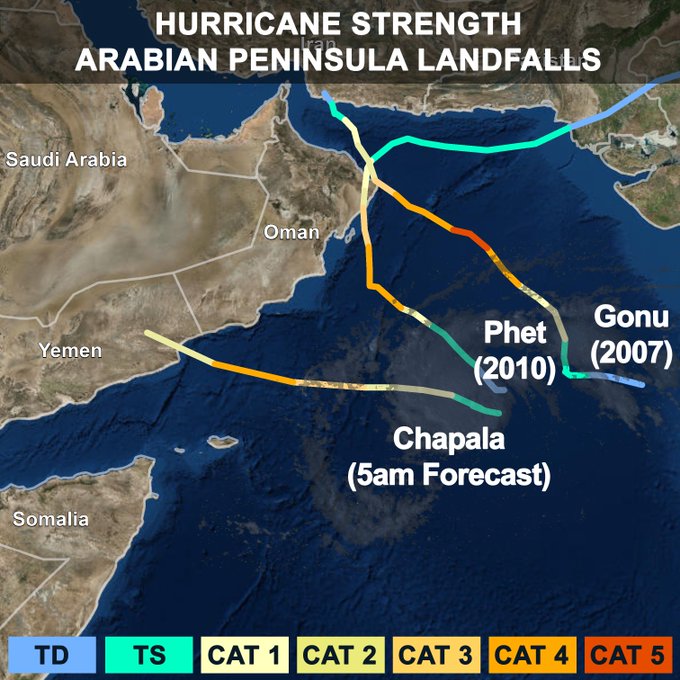Published: October 29,2015
While not an especially large circulation, Cyclone Chapala currently is estimated to have winds of Category 2 hurricane intensity and is gaining strength.
Chapala was beginning to show a well-formed eye via satellite imagery Thursday night, mainland U.S. time, further signs that the storm is continuing to better organize.

Cyclone Chapala: Current Status
(MORE: Why Tropical Cyclones Are Named)
Continued intensification is expected, due not only to warmer-than-average Arabian Sea water along its path, but also due to an impressive upper-atmospheric outflow channel stretching hundreds of miles to the east-northeast of Chapala from an upper-atmospheric low-pressure area over northern India.
Impressive outflow channel N of Cyclone #Chapala. Shows the fine line between being sheared apart & possible RI.
In short, particularly in cases of a small circulation such as Chapala, rapid intensification (an increase in wind speed of at least 30 knots in 24 hours or less) can occur when an impressive upper-atmospheric outflow channel couples with warm water.
(RECAP: Hurricane Patricia Strongest Landfalling Pacific Hurricane On Record)
By this weekend, if not sooner, Cyclone Chapala may be the equivalent of a Category 4 storm.
Steered by subtropical high pressure, Chapala is expected to track west or west-northwest over the next several days, eventually nearing the coast of eastern Yemen or southwest Oman Monday or Tuesday.

Cyclone Chapala's Forecast Path
In this case, we expect Chapala to make landfall as a weaker, possibly much weaker cyclone than its potential maximum intensity over the Arabian Sea. Small tropical cyclones can both intensify rapidly and weaken rapidly.
The threat of heavy rainfall should be in play regardless of the intensity.
Chapala has the potential to dump a year's worth of rain or more in just a day or two over parts of eastern Yemen and southwest Oman. According to worldclimate.com, the average annual rainfall in Salalah, Oman (estimated population 197,000 as of 2009), is only around 4 inches.

Model Rainfall Forecast: Cyclone Chapala
(INTERACTIVE: Oman/Yemen Coast in the Path of Chapala)
Rivers running from these mountains that are normally dry or feature very low flow would see rapid rises with rainfall of this magnitude, which could be destructive or deadly.
Unprecedented Landfall?
You may wonder how often "tropical cyclone" and the "Arabian Peninsula" appear in the same sentence. How unusual could Chapala be?First, according to hurricane specialist Michael Lowry and the NOAA best track database, there is no record of a hurricane-strength cyclone landfall in Yemen dating to 1945.
#Chapala forecast to hit Arabian Peninsula as only 3rd hurricane strength landfall on record. Big rains to dry area.
There is no record of a cyclone of Category 4 strength tracking as far south as Chapala in the Arabian Sea.
(MORE: Hurricanes in Strange Places
Despite all this, Arabian Sea tropical cyclones are not as unusual as they sound.
Each year, an average of one to two tropical cyclones form in the Arabian Sea, according to a 2011 climatology study by Amato Evan and Suzana Camargo.
 Tracks
of all recorded global tropical cyclones from 1851-2008. Tracks in the
Arabian Sea are highlighted by the yellow box. (NOAA/NCDC)
Tracks
of all recorded global tropical cyclones from 1851-2008. Tracks in the
Arabian Sea are highlighted by the yellow box. (NOAA/NCDC)These cyclones are most likely to form in two periods: from May through June and October through November. The mid-late summer period is typically not favorable, thanks to increased wind shear from the wet phase of the Asian monsoon.
(MORE: Where the Season Peaks Twice)
In June 2007, Cyclone Gonu was the most intense Arabian Sea storm on record, making landfall in Oman, then in southern Iran.
Gonu claimed 100 lives in Oman, Iran and the United Arab Emirates and was responsible for $4 billion in damage, according to the Evan and Camargo study.
Almost exactly three years later, Cyclone Phet alarmingly intensified to a Category 4 equivalent cyclone, before weakening to a Category 1 storm upon making landfall on the eastern tip of Oman, east of the capital city of Muscat.
In May 1999, Cyclone ARB 01 slammed into Pakistan near Karachi as a strong Category 3 equivalent storm, killing at least 700 in Pakistan. This was the strongest tropical cyclone on record to hit Pakistan.
(MORE: Deadliest Tropical Cyclones in World History)
In the limited historical record, however, strong cyclones in the Arabian Sea are more rare than other basins, due to the proximity of dry air from the Arabian Desert, the aforementioned increased wind shear during the wet phase of the Asian monsoon, and the basin's overall small size.






No comments:
Post a Comment